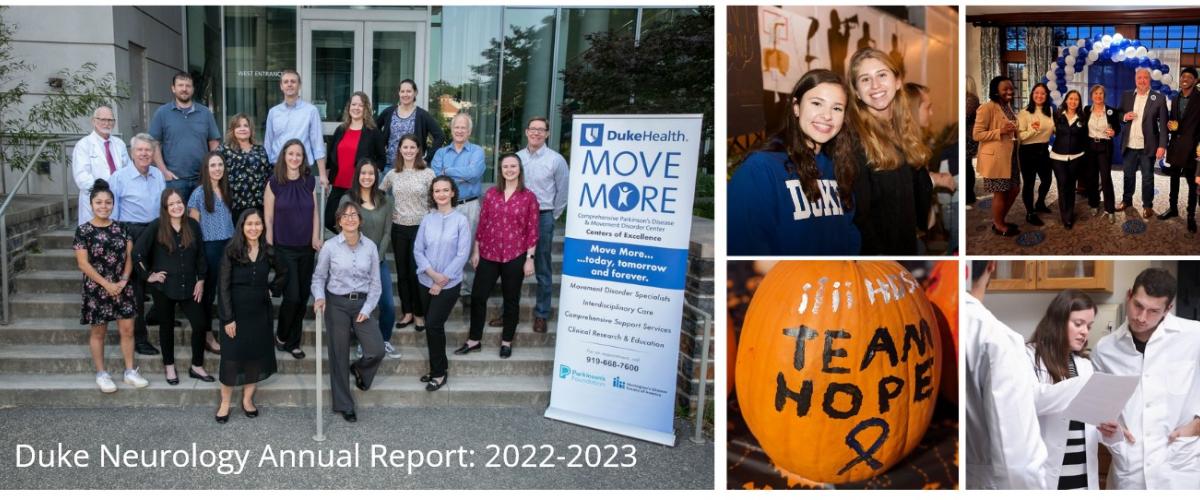
January
A new study by Sneha Mantri, MD, MS, and colleagues advances our understanding of the relationship between fatigue and quality of life for people living with Parkinson’s disease. Their survey of more than 1,000 patients found associations between fatigue and lower quality of life are strongest in younger and more depressed individuals, suggesting that targeted therapies may have the best impact on this group.
February
Our Huntington’s Disease Clinic expands from offering three to four sessions a month, doubling its capacity from 2020. As North Carolina’s only nationally designated Huntington’s Disease Society of America Center of Excellence, Duke experts provide care to people who are living with or at risk for Huntington’s.
March
People living with Parkinson’s and their carepartners gather over zoom for our monthly Parkinson’s Disease Support Group. During this month’s meeting, patients and their carepartners share and discuss their favorite devices, hacks, and solutions to Parkinson’s concerns.
April
The American Academy of Neurology (AAN) awards Noreen Bukhari-Parlakturk, MD, PhD, its Career Development Award, for her project, “Non-invasive modulation of deep brain networks for treatment of movement disorders” at its annual meeting in Seattle. This project will examine the potential for transcranial magnetic stimulation of the corticostriatal circuit of the brain to develop potential therapies for dystonia and, eventually, other movement disorders.
May
Matt Weeks and Sara Smouther, both of whom are living with Huntington's disease, celebrate their wedding under an arch decorated with flowers and paper butterflies in their hometown of Cloverdale, Indiana. Later that year, People magazine shares their story, speaking with Burton Scott, MD, PhD, about the development and progression of Huntington’s disease.
June
Our Movement Disorder Fellowship Program expands in number and scope, thanks to support from the Shulsky Foundation and Tyler’s Hope for a Cure. This expansion allows Rabia Ghazi, MBBS, to begin a second year of her fellowship focusing on clinical research for dystonia. She is joined by incoming fellow Brian Dahlben, MD, MSc, bringing our total of Movement Disorders fellows for two for the first time
July
U.S. News & World Report ranked Duke University Hospital as the top hospital in North Carolina and the 23rd best of more than 4,500 hospitals across the nation for neurology and neurosurgery in its 2022-2023 hospital rankings, an increase of eight places from its 2021-2022 position.
August
The journal Movement Disorders publishes a new commentary co-authored by Jeffrey Cooney, MD, summarizing the state of fellowship training in movement disorders in the United States and offering new directions for program development.
September
The Tyler’s Hope for a Dystonia Cure Foundation officially recognizes Duke Health as the country’s second Center of Excellence for Dystonia. This distinction reflects Duke’s growth as a national leader in dystonia patient care, education, and research as well as a continuing partnership with Tyler’s Hope.
October
Nicole Calakos, MD, PhD, a professor of neurology and Lincoln Financial Group Distinguished Professor of Neurobiology, is one of 31 Duke faculty elected to the U.S. National Academy of Medicine. Election to the Academy is considered one of the highest honors in the fields of health and medicine.
November
Chaplain Katherine Henderson joins our interdisciplinary Benchmark Clinic at Morreene Rd to help support patients and families living with Parkinson's disease. As a non-denominational chaplain, Henderson provides spiritual care for patients, families, caregivers and staff of all religions, belief systems and worldviews.
December
Laurie Sanders, PhD, is promoted to Associate Professor in recognition of her numerous contributions to our understanding of Parkinson’s disease. Sanders’ research takes a bench-to-bedside approach, aiming to translate her multidisciplinary basic scientific research into meaningful health outcomes for people living with the condition, with a primary focus on how genome integrity and DNA repair contribute to the origins of Parkinson’s.